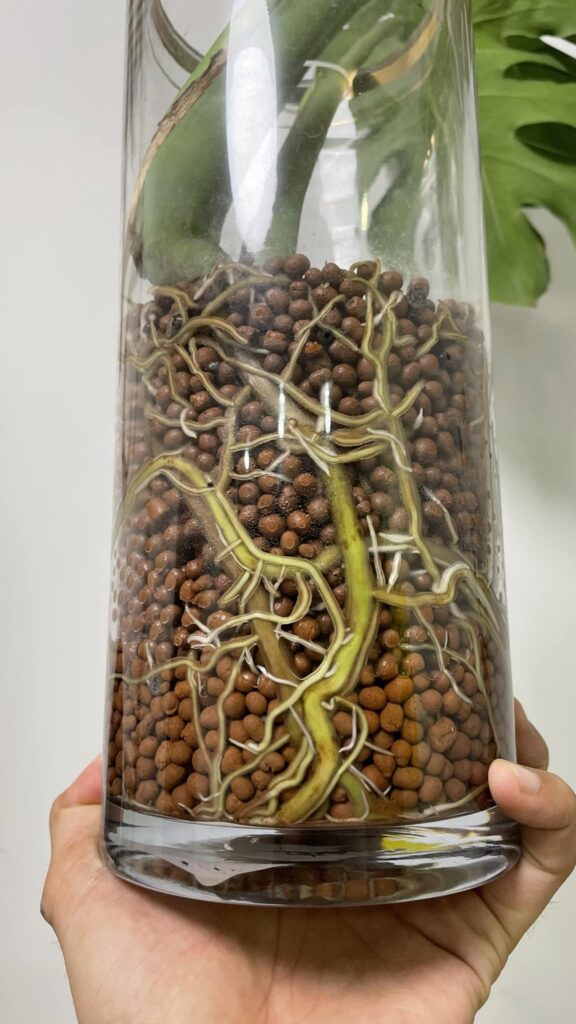Ready to grow your houseplants in LECA and Pon? You’re diving into the world of “Semi-Hydroponics,” and we’re here to guide you through the various potting methods, along with their benefits and drawbacks.
But first, let’s get a quick grasp of hydroponics.
Hydroponics offers a variety of setups, each with its own set of advantages and disadvantages. When it comes to semi-hydroponics, the focus is on passive hydroponics. This means there’s no need for water pumps or sprayers to circulate water.
Generally, semi-hydroponic methods fall into two main categories.
- The first involves using a wick, like a string or a piece of microfiber cloth.
- The second doesn’t use a wick, relying instead on LECA/Pon’s natural ability to soak up water from a reservoir.
Recommended Self-Watering Pots for LECA/Pon (Semi-Hydro)
| Preview | Product | Description |
|---|---|---|
| Terracotta Self-Watering Planter | Perfect for plant enthusiasts and fitting any decor style | |
 | Self-Watering Pot | Large reservoir, budget-friendly |
| Transparent Self-Watering Pot | Transparent, easy algae cleanup | |
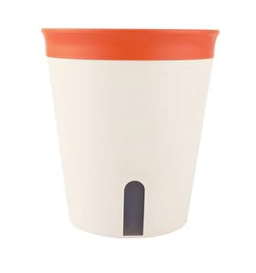 | Artistical Self-Watering Pots | Stylish, sturdy, water-level window |
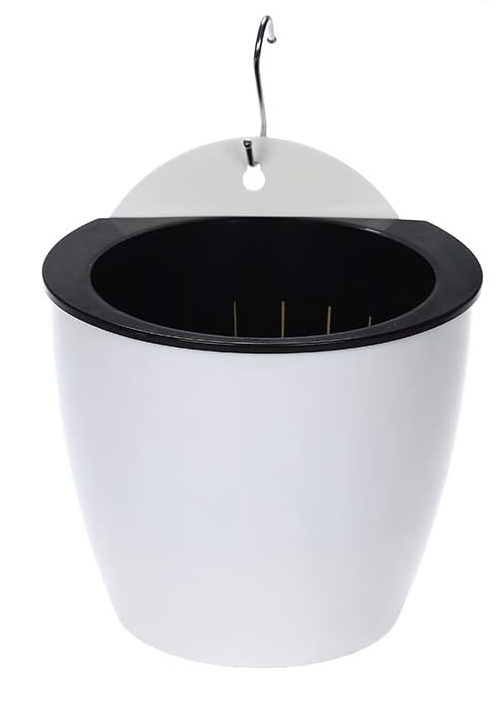 | Hangable & Compact Self-Watering Pots | Versatile, great for tight spaces |
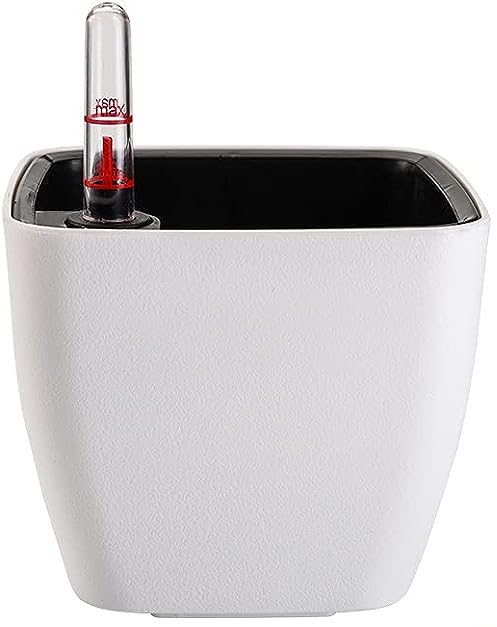 | Wick-Free Self-Watering Pots | No wick, budget-friendly, easy to check water level. |
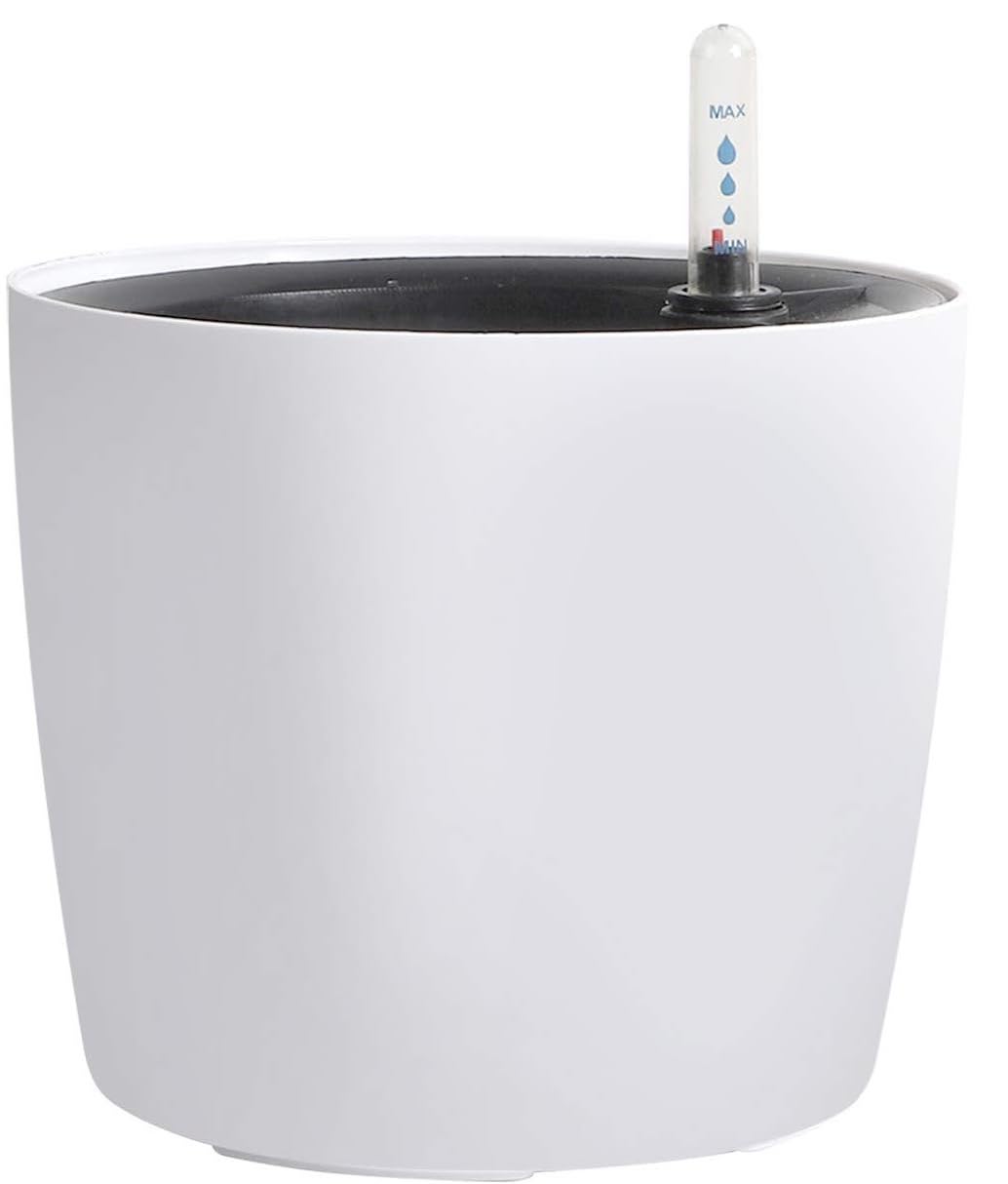 | The Big Pots | Large size, multiple colors |
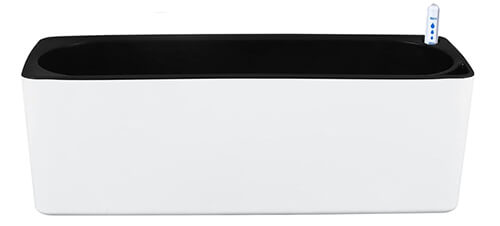 | Rectangular Planter | For crawler plants like Philodendrons. 15.6″ x 5.4″ x 5.2″ |
 | Bigger & High-quality Rectangular Planter | For crawler plants like Philodendrons. 20″ x 7″ x 7″ |
| 24oz Deli Containers | Budget-friendly, DIY orchid pot | |
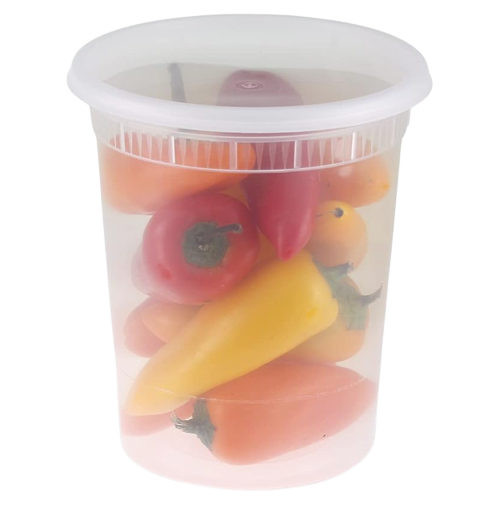 | 32oz Deli Containers | Versatile, great for repurposing |
| 3″ Net Pots | Ideal for small plants and cuttings |
Wick-Based Pots: Nutrient Static Wick (NSW)
In a wick-based setup, a wick—often a cotton string or microfiber cloth—draws nutrient-rich water from a reservoir to the medium.
This is known in hydroponic lingo as the “Nutrient Static Wick” or NSW method.
Research shows that this method is effective, as both water and nutrients are efficiently absorbed by the LECA & Pon and then transferred to the plant.
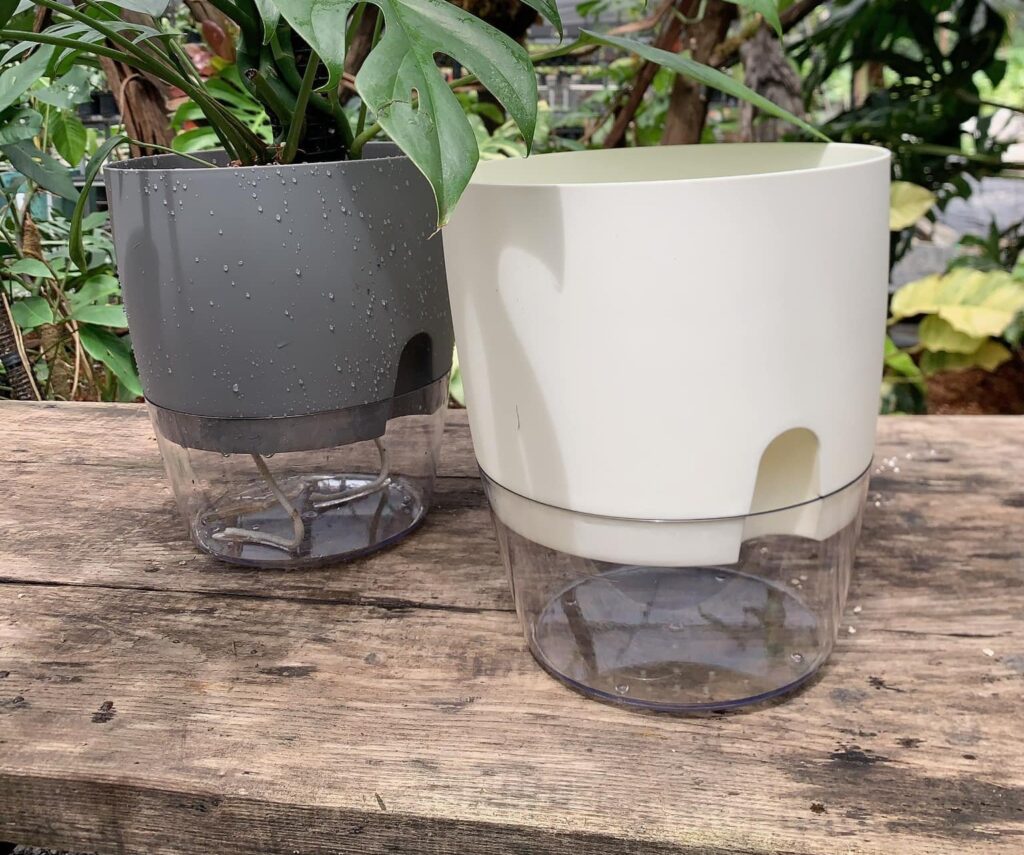
Holes are made at the bottom, and a microfiber wick is threaded through. The LECA/Pon medium sits on top of this wick.
There are a few types of pots like this right now. One features a wick hanging in nutrient water, ensuring the water never directly touches the medium. While the others offer a clear view of the water level, making it easier to know when to water your plant.
Pros
- Wick Placement Control: You can adjust the wick’s position to control the moisture level in the LECA & Pon. For instance, coiling the wick inside the LECA & Pon creates a more humid environment.
- Larger Reservoir: Commercial self-watering pots can hold up to half a cup of water or more, offering a bigger reservoir compared to submerged setups.
- Nutrient Monitoring: This setup allows you to easily check the pH or nutrient concentration by lifting the inner pot.
- Root Oxygenation: Some roots may grow into the outer pot, which is actually great for extra oxygen supply to the root system.
- Easy Maintenance: Simply run water through the inner pot to flush it out. Clean the reservoir and refill.
Cons
- Wick Degradation: Cotton wicks can wear out over time. It’s advisable to use microfiber wicks as they are more durable.
- Slightly Pricier: This method may require an initial investment in self-watering pots or multiple deli containers.
Terracotta Self Watering Planter
- Terracotta’s porosity allows for automatic water absorption, ensuring plant roots receive moisture without a drainage hole. Simply half-fill the glass container with water.
- Chic terracotta and clear glass design, perfect for plant enthusiasts and fitting any decor style.
- No drainage holes mean no leaks, keeping surfaces clean.
- Set comes with a terracotta pot and glass cup, ideal for herbs and small plants.
Non-Wick Pots: The Submerged Medium Setup
In a submerged LECA & Pon setup, the medium is directly in contact with the nutrient solution. Unlike the wick-based method, this approach relies solely on the capillary action of LECA to pull water from the reservoir.
This is still a Nutrient Stagnant system, but there’s no wick to act as a middleman for water absorption.
In the image above, the glass jar is a popular choice among semi-hydroponic enthusiasts. While its popularity might be attributed to TikTok trends, I find this setup has its limitations, which I’ll discuss below.
Some people drill a hole a third of the way up from the bottom, but I generally avoid this setup.
However, it’s my go-to method for transitioning a plant from soil to LECA & Pon, as it allows me to monitor both water levels and root growth.
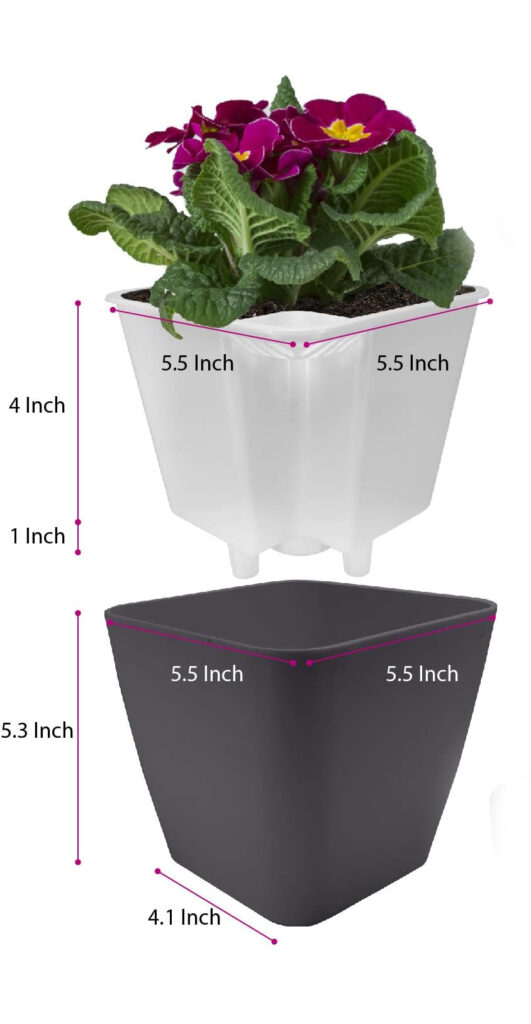
The white pot on the right is a versatile option available on Amazon. Its bottom is detachable, making it easy to flush the system. The medium at the bottom, shaped like an “X,” is in contact with the water reservoir and wicks water up to the plant roots. I prefer these over glass jars due to their larger reservoirs.
The white pot in the back left is a high-end Lechuza-style pot. It also relies on medium’s capillary action, as the LECA & Pon in the inner pot is in direct contact with the water reservoir. This pot features a large reservoir and a gauge to show water levels. It’s a bit on the pricey side, but it’s a great investment.
Pros
- Visibility: This method is excellent for transitioning plants, as it allows you to keep tabs on water levels and root growth.
- Easy Maintenance: Detachable bottoms make it simple to flush the system.
- Larger Reservoirs: Some pots offer bigger reservoirs, which means less frequent watering.
Cons
- Limited Control: Without a wick, you have less control over the moisture level in the LECA & Pon.
- Cost: Some of the more advanced pots can be a bit pricey.
The Net Pot Inside a Plastic Cup: A Hybrid Approach

For those who love to geek out on plant care, the net pot inside a plastic cup setup is a fascinating option.
This method allows you to easily measure nutrient levels and observe water consumption, making it a step up from the basic jar method. You can use it as a submerged setup or even add a wick to create a wicking system.
Another intriguing twist is the Kratky method, where the water reservoir is lowered an inch from the net pot’s bottom. In this setup, LECA & Pon mainly serves to stabilize the plant, especially when it’s young. The roots eventually grow into the water, and the reservoir is never refilled to touch the LECA & Pon again. While Kratky is generally better suited for annuals or fruiting plants, it can work for houseplants too, as I’ve found with my Monstera Thai Constellation.
Pros
- Visual Monitoring: Glass jars make it easy to keep an eye on root growth and water levels, adding an aesthetic touch to your medium gardening.
- Direct Nutrient Delivery: With no wick to worry about, you can be sure that nutrients are reaching the roots directly.
Cons
- Limited Access for Testing: Unlike wick-based setups, glass jars make it challenging to measure nutrient levels unless you opt for specialized self-watering pots.
- Smaller Reservoir: This method often requires more frequent watering due to limited reservoir space, especially for thirsty plants like Monstera Deliciosa.
- Root Competition: Over time, roots will grow into the reservoir, competing with LECA & Pon for space and requiring even more frequent watering.
- Repotting Risks: Constantly moving your plant to accommodate root growth can stress it out and should be avoided.
- Root Rot: For certain plants like Hoyas, this setup can lead to root rot over an extended period. A wet-dry cycle is a better alternative.
- Safety Concerns: Drilling holes in glass jars can be risky, posing potential hazards like eye injury from glass particles.
- Algae Buildup: Over time, glass jars are prone to algae growth, which can be unsightly.
Whether you’re a casual gardener or a plant aficionado, understanding these LECA & Ponpotting methods can help you make an informed choice for your houseplants. Each method has its pros and cons, so choose the one that best suits your needs and your plants’ specific requirements.
Additional Factors to Consider When Choosing Self-Watering Pots (Planters)
The Algae Struggle
Algae is a common issue when using clear pots, and it’s one of the main reasons I’m not a fan of the glass jar setup. Whether it’s stacked deli pots, clear plastic outer pots, or net pots in large Tupperware containers, algae seems to find a way.
Using opaque pots eliminates this issue but comes with the drawback of not being able to see the water level, making watering a bit of a guessing game.
So, consider your LECA & Pongardening goals and choose a pot that aligns with your lifestyle.
Tip: Mix Hydro peroxide with water can help you deal with algae in the short term.
Mixing and Matching Configurations
I often use both wicking and non-wicking setups. For transitioning plants, a clear container—be it a deli pot or a glass jar—works well. I avoid double-deli setups as a single pot is much easier to manage.
For smaller cuttings, a 2-inch plastic cup does the trick. Once a plant is well-established, I usually move it to a wicking system with an opaque outer pot to combat algae growth.
The Dream Pot
My ideal pot would have a clear inner section for monitoring root growth, housed within an opaque outer pot to prevent algae. A small window at the bottom would allow for easy water level checks.
By understanding these additional factors and considerations, you can make a more informed decision on which LECA & Pon potting method is right for you and your plants. Whether you’re battling algae or looking for the perfect pot, there’s a solution that fits your needs.
To Use or Not Use Wick in Semy-Hydro System?
The necessity and effectiveness of wicks in semi-hydroponic pots can be a polarizing topic. In my experience, wicks aren’t always required and might not be the best choice for certain plants.
The reason is that wicks can restrict water intake, which could be beneficial or detrimental depending on the plant’s specific needs. It’s important to remember that water roots are inherently designed to absorb water efficiently.
Many plants like Alocasia or Philodendron, except those native to arid desert environments, thrive in moist conditions and are accustomed to high humidity levels. Therefore, the concept of using wicks to limit water availability might not align with the natural water needs of these “thirsty” plants.
It’s worth noting that the medium or substrate within a semi-hydro system can naturally perform capillary action, drawing water up from the reservoir to the plant’s roots without the need for a wick. Similarly, terracotta pots can also wick moisture to support plant hydration effectively.
Terracotta Self Watering Planter
- Terracotta’s porosity allows for automatic water absorption, ensuring plant roots receive moisture without a drainage hole. Simply half-fill the glass container with water.
- Chic terracotta and clear glass design, perfect for plant enthusiasts and fitting any decor style.
- No drainage holes mean no leaks, keeping surfaces clean.
- Set comes with a terracotta pot and glass cup, ideal for herbs and small plants.
Concerns about ensuring adequate oxygen supply amidst the water and medium interface are valid. However, using porous media like LECA can enhance gas exchange, making wicks less critical. Opting for cache pots with sufficient airflow through the sides and bottom can further improve the oxygenation of the root zone, compared to using non-porous containers like glass vases.


